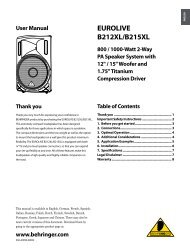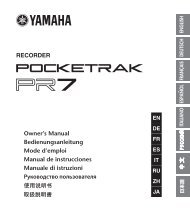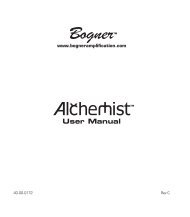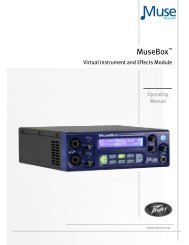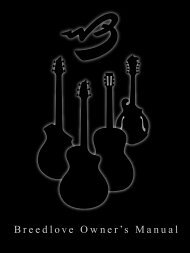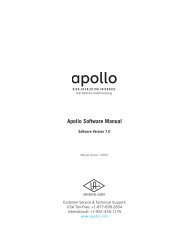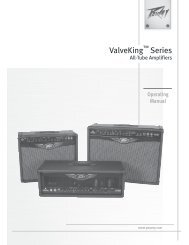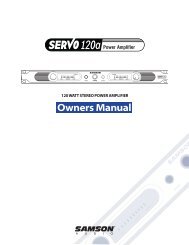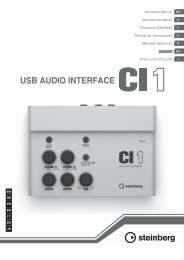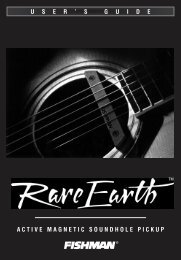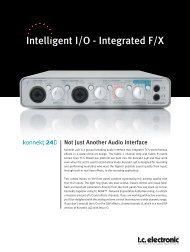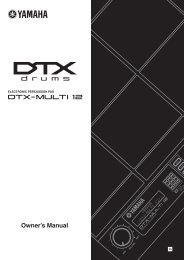microARRANGER Quick Start Guide - Korg
microARRANGER Quick Start Guide - Korg
microARRANGER Quick Start Guide - Korg
You also want an ePaper? Increase the reach of your titles
YUMPU automatically turns print PDFs into web optimized ePapers that Google loves.
<strong>Start</strong> up<br />
Controlling the Volume<br />
2<br />
ABOUT THE AUTO POWER-OFF FUNCTION<br />
With the factory settings, this instrument will automatically<br />
power‐off when four hours have passed since you last played<br />
the keyboard or used the buttons. If desired, you can turn off<br />
(disable) this function.<br />
The power will also turn off automatically after four hours<br />
pass with only songs or demo songs being played.<br />
To adjust power on/off settings, press the [GLOBAL] button<br />
to enter the GLOBAL page, and adjust the settings on the<br />
Page1‐Gen.Controls page.<br />
CONTROLLING THE VOLUME<br />
• Use the MASTER VOLUME<br />
slider to control the overall<br />
volume of the instrument.<br />
This slider controls the volume<br />
of the sound going to<br />
the internal speakers,<br />
the L/MONO & RIGHT<br />
OUTPUTS, and the HEAD‐<br />
PHONES connector.<br />
Note: <strong>Start</strong> at a moderate level,<br />
then raise the MASTER VOLUME up. Don’t keep the volume<br />
at an uncomfortable level for too long.<br />
• Use the ACC/SEQ VOLUME slider to control the Style<br />
tracks (drums, percussion, bass…) volume. This slider<br />
also controls both of the Sequencers tracks, excluding<br />
the Realtime (Keyboard) tracks.<br />
• By default, you can use the ASSIGN.SLIDER to control<br />
the keyboard tracks volume. This slider is user‐assignable,<br />
but is set to the Keyboard Expression parameter by<br />
default.<br />
THE BALANCE SLIDER<br />
The BALANCE slider sets the relative volume of the two<br />
onboard sequencers (Sequencer1 and Sequencer 2).<br />
• Move it fully left to set Sequencer 1 to the maximum<br />
level and Sequencer 2 to zero.<br />
• Move it fully right to set Sequencer 1 to zero and<br />
Sequencer 2 to the maximum level.<br />
• Move it to the center to set both Sequencers at the same<br />
level.<br />
Note: When turning the instrument on, move this slider to the center,<br />
to avoid starting a Song at the minimum level.<br />
HEADPHONES<br />
You can connect a pair of headphones to the rear panel headphone<br />
jack (PHONES: stereo mini‐jack). You can use headphones<br />
with an impedance of 16–200Ω (50Ω recommended).<br />
Use the connected device’s volume control to adjust the input<br />
level. Be careful not to make it distort (or “clip”). Here is how<br />
to set the volume of the connected device:<br />
• if the sound heard on <strong>microARRANGER</strong>’s outputs is too<br />
low, you should increase the output level of the connected<br />
device.<br />
• if it sounds fine, it’s ok.<br />
• if it distorts, you should lower the level a little, until the<br />
sounds is fine again.<br />
MIDI CONNECTIONS<br />
You can play the internal sounds of your <strong>microARRANGER</strong><br />
with an external controller, i.e. a master keyboard, a MIDI<br />
guitar, a wind controller, a MIDI accordion, or a digital piano.<br />
1. Connect a standard MIDI cable from the MIDI OUT of<br />
your controller to the MIDI IN connector on the micro‐<br />
ARRANGER.<br />
2. Select a transmission MIDI channel on your controller.<br />
Some controllers, like the MIDI accordions, usually<br />
transmit on more than one channel.<br />
3. On the <strong>microARRANGER</strong>, select the MIDI Setup that<br />
best fits your controller’s type.<br />
DAMPER PEDAL<br />
Connect a Damper (Sustain) pedal to the DAMPER connector<br />
on the back panel. Use a KORG PS‐1, PS‐3 or DS1H footswitch<br />
pedal, or a compatible one.<br />
DEMO<br />
Listen to the built‐in Demo Songs to appreciate the power of the<br />
<strong>microARRANGER</strong>. There are 16 Demo Songs to choose from.<br />
1. Press the STYLE PLAY and SONG PLAY buttons<br />
together. Their LEDs start blinking.<br />
At this point, if you don’t press any other button, all the<br />
Demo Songs will be played back.<br />
2. Choose a page using the PAGE buttons. There are two<br />
different pages in the Demo mode.<br />
3. Select a Demo Song by pressing the corresponding VOL‐<br />
UME/VALUE button around the display. The Demo will<br />
automatically start.<br />
4. Stop the Demo by pressing START/STOP.<br />
5. Exit the Demo mode by pressing one of the MODE buttons.<br />
THE MUSIC STAND<br />
A music stand comes standard with your <strong>microARRANGER</strong>.<br />
Fit it into the two dedicated holes in the front panel.<br />
AUDIO OUTPUTS<br />
You can send the sound to an external amplification system,<br />
instead of the internal speakers. This is useful when recording,<br />
or when playing live.<br />
AUDIO INPUTS<br />
You can connect the output of another electronic musical<br />
instrument, an unpowered mixer, or any audio device to the<br />
rear panel input jack (INPUT: stereo mini‐jack). Since this is a<br />
line‐level input, youʹll need to use a separately sold mic preamp<br />
or mixer if youʹre connecting a mic.



